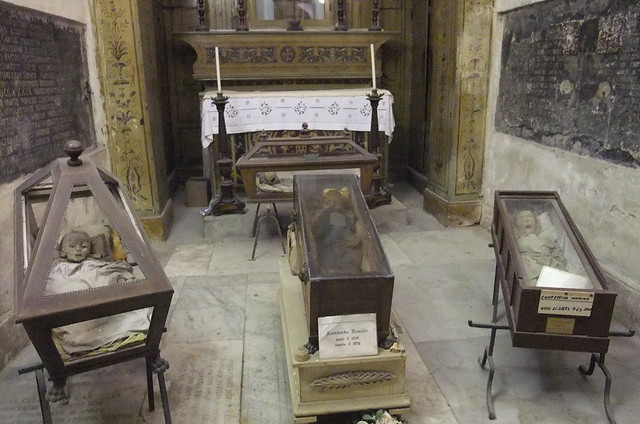A few days ago I attended a funeral and as always after such an event people talk about wheter it's better to be cremated rather than simply buried into the ground after you die. All this talking reminded me about something my mother told me some time ago. Many years ago she visited the catacombs in the city of Palermo in Sicily (the famous Italian island) and she saw the mummy of this little girl called Rosalia Lombardo whose body was fully preserved and she didn't look dead but more as she was just sleeping. My mother told me it was really impressive, not something you could easily forget. As she couldn't fully recall all the historical fact and exactly who Rosalia was, I made a little research on the web and I share with you what I found about her:
"One of the last bodies laid to rest in the Catacombs of the Capuchin monks of Palermo, Italy, was Rosalia Lombardo. Her preserved corpse is the most famous of the 8,000 bodies once found in the catacombs. Only two years old when she died on December 6, 1920, apparently of a bronchial infection, Rosalia has gained fame because of the excellent preservation of her body. She is often referred to as "The Sleeping Beauty".
Her embalmer was Professor Alfredo Salafia, an Italian chemist who discovered a way to preserve bodies using a special formula. Starting first with animals then people, Salafia perfected his process. Eventually, he embalmed his own father.
Once word spread about his special embalming abilities, the relatives of many famous people began to contact him.
In 1910 he tried to launch The Salafia Permanent Method Embalming Company to assist American funeral directors. To demonstrate his technique, he went to the United States and embalmed the unclaimed body of a recently deceased man at the Eclectic Medical College in New York. The man had died some ten days earlier and his body exhibited black and green areas on the face and neck. Fifteen gallons of Salafia's embalming fluid were injected distally into the right common carotid artery without draining the blood, treating the cavities, or carrying out secondary injections. Then the body was stored without refrigeration, though the exact location is apparently not recorded. It is safe to assume, however, that it would have been kept in a cool place.
Six months later, the body was dissected. Salafia's embalming technique had done the trick: his green and black patches on the skin had pretty much disappeared. What's more, the body was well-preserved, with the skin firm, and moderately hard and dry. No odor of decomposition, or fecal odor, was present, only the chemical odor of the embalming fluid.
In September 1910, a second body was embalmed in Syracuse New York. The deceased, however, had suffered from arteriosclerosis and the embalmer (Professor Achille Salomone, a nephew of Salafia) was unable to inject more than six quarts of the fluid. Six months later, when the body was dissected, attendees concluded that Salafia's method worked wherever it was able to penetrate the tissue (which wasn't universally possible). According to embalmers, this is still the case with injected fluid. In 1911, his company began to sell the embalming liquid to American funeral parlors.
The details of his life from this point are vague. A year later, his fluid was no longer advertised, and Dr. Salafia was back in Italy. In 1920 he embalmed the body of Rosalia. Salafia died in 1933 without releasing the secret of his embalming fluid.
Researchers figured that Salafia's formula was most likely an arsenic-based treatment, which was popular at the time that Salafia was perfecting his embalming process. According to the Handbook of Death & Dying by Clifton D. Bryant, Salafia was a student of Dr. Tranchini from Naples who was a proponent of arsenic-based embalming. Tranchini's formula used one pound of dry arsenic dissolved in wine to create a two-gallon solution. It was then injected into the femoral or carotid artery. Many believed that Salafia's method was a variation of this formula.
In fact, arsenic was not part of the formula. Recent studies state that the ingredients were: formalin (a mix of formaldehyde and water) that was used to kill bacteria; alcohol to dry Rosalia's body; glycerin to stop the body from drying out too much; and salicylic acid to stop the growth of fungus. According to other fonts, the formula used for Rosalia contained also zync but was not more used because it caused too much rigidity.
Rosalia Lombardo shares her name with Saint Rosalia, the patron saint of Palermo. Saint-to-be Rosalia spent the better part of her life in a cavern, where she died in 1170. Many subsequent miracles are attributed to Rosalia, the first and most important of which occurred in July 1624 when a plague was ravaging Palermo. Her well-preserved body was discovered at that time in the cave; this discovery coincided with the end of the epidemic. Many small shrines honoring Saint Rosalia are visible throughout Palermo, but the Santuario di Santa Rosalia is the ultimate shrine. It is in the cave where her preserved body was discovered. This connection makes little Rosalia, the "Sleeping Beauty," an even more-beloved icon.
Rosalia can be seen at the Capuchin Catacombs in Palermo, Italy. Her glass-covered coffin is located in a small chapel at the end of the self-guided catacomb tour. During my last visit, her face was not visible through the glass and visitors are not permitted to enter the chapel for a closer look. The glass case appears rather grimy, and it is not possible to see Rosalia's face with any clarity.

info taken from: www.mummytombs.com


























No comments:
Post a Comment